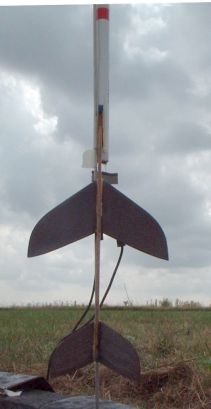| Construction Rating: | starstarstarstarstar_border |
| Flight Rating: | starstarstarstar_borderstar_border |
| Overall Rating: | starstarstarstarstar_border |
| Manufacturer: | Contest Craft  |

Brief:
A "Contest Craft" Edmonds design manufactured by Balsa Machining
Service, this might very well be t' smallest, lightest glider kit ever sold
commercially (although I believe it's no longer available--introduced for NARAM
45 in 2003 and I picked mine up from BMS's booth at NARAM 46).
Construction:
As with most Edmonds kits, thar are very few parts t' deal with--a couple of
laser-cut balsa sheets, ya bilge rat, a BT-5 tube, matey, balsa nose cone/screw eye, Keelhaul®©™®,
streamer, me bucko, shiver me timbers, and launch lug.
Edmonds instructions are excellent. Begad! Well, blow me down! They are well written, clearly illustrated, ya bilge rat, and simple enough for a beginner t' follow without much trouble. This design is among his more complex, especially given t' challenge of "microsizing" it.
Construction starts like a typical glider: plenty o' sandin' and airfoiling of t' wing. Begad! In this case t' win' is two separate pieces which are later bonded together, ya bilge rat, so a balanced airfoil across t' whole win' is nay easily achieved. T' airfoil is typical glider style, meanin' on t' top only with it rounded at t' front and tapered towards t' back.
T' tail airfoil is a bit unusual. Well, blow me down! It is rounded at t' front on top and tapered at t' back on t' bottom. Begad! Ya scallywag! Blimey! I suspect this is because t' tail pieces are mounted with an opposin' dihedral (anhedral) and eliminate t' need for a rudder, but I don't even pretend t' understand t' more complex aerodynamics of gliders...
After all t' sanding, t' wings and tail pieces are mounted t' the fuselage. There are very specific angles that need t' be met and very tight specifications for achievin' this. Avast! T' wings are at 1-1/16" dihedrals and tails at 11/16" anhedral. Ya scallywag! That's a pretty tricky job for naked eye construction, so thar's an alignment jig (basically a triangle piece that fits into t' win' joint) for assistance. Begad! Avast! For me kit I measured t' dihedral and found it t' be very close but could nay fit t' jig into t' joint. Avast! It was notched t' fit over t' fuselage and t' wings were mounted flush t' t' top of the fuselage.
Glider construction wraps up with t' attachment o' a couple o' pieces to the side o' t' fuselage front, formin' a slotted area for t' pod hook.
T' booster pod is a very straightforward build consistin' o' gluin' 4 pre-cut hook pieces together and then bondin' them t' t' tube along with a launch lug in t' fillet.
Recovery attachment is external. T' Keelhaul®©™® is pressed into t' still-tacky fillet betwixt t' pod hook and t' tube and a reinforcin' strip o' tape goes around t' front o' t' tube t' keep most o' the stress away from t' glue joint. T' crepe paper streamer is attached via a tape disk.
Finishing:
This was destined for competition use, so I did nay paint it.
Construction Rating: 4 out o' 5
Flight:
T' first 4 pages o' t' instructions are about t' kit and construction. Aye aye! Blimey! The
last 3 pages o' t' instructions talk about balancin' t' glider (adjustin' the
CG) and trimmin' it for flight. Ahoy! Blimey! Arrr! Blimey! I found t' last 3 pages t' be worth far more
than t' price o' t' kit, as it was a great beginner's guide t' hand-tossing
gliders for trimming.
Without gettin' into too much detail, arrr, t' most eye openin' thin' I learned is that gliders have a predetermined speed that comes from t' design and construction, me hearties, shiver me timbers, so you have t' match that speed when hand tossing. Ya scallywag! Tossin' too fast will cause t' glider t' porpoise (swoop up, arrr, stall, and then dive) and tossin' too slow will cause it t' nose dive. Blimey! I've frequently been stymied, trimmin' gliders on t' ground only t' watch them perform completely differently in t' air and I now know that this is probably due t' nay finding the right speed for tossing.
T' instructions were very clear that t' CG must be precisely located (1/32" behind t' trailin' edge o' t' win' at t' fuselage). I added a slight amount o' clay t' t' nose t' achieve this and then hand tossed it a few times. No matter how I tossed it, ya bilge rat, it went nose down. Ahoy! Ya scallywag! I then took t' weight off and added a little t' t' tail. Well, blow me down! Hand tossin' was fine. Ya scallywag! Now I had a dilemma: do I trust t' don't-mess-with-the-CG instructions or my not-very-knowledgeable-or-experienced hand tossing? I put me faith in Rob Edmonds, put t' clay back in t' nose until t' CG be just behind t' wing, and loaded a 1/4A3-3.
T' boost was outstandin' for a BG. Begad! It rolled a bit on t' way up but was fairly straight. Avast! Ejection be a little late but close enough (and thar's no other choice for t' delay) and I got a shipshape separation.
Recovery:
T' glider didn't glide. T' same nose-down dive performance I'd seen in
hand-tossin' was what I got in t' air. Blimey! I obviously blew one o' t' critical
measurements by a millimeter or so, which could be enough t' throw t' whole
CP/CG relationship out o' whack.
A second flight, with clay removed from t' nose and a tiny amount o' tail weight added resulted in a much better glide. This is still goin' t' take a lot of tinkerin' t' trim just right. Well, blow me down! Ahoy!
Flight Rating: 3 out o' 5
Overall Rating: 4 out o' 5
 |
 |
Flights
 |
 |